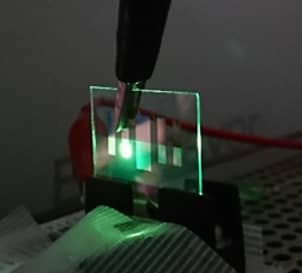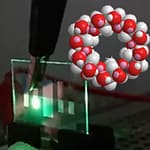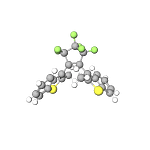やさしく解説:2025年のOLEDハイライト — 「超低電力」「円偏光」「深赤MR-TADF」「超透明フレキ電極」【日本語版】
更新日:2025-11-24 / 対象:一般向け解説
<!– ADSENSE: 目次直下(カスタムHTMLで差し込み) –>
本ページは、2025年に報告された代表的なOLED研究トピックをわかりやすく要点整理したものです(Science / Nature Communications / Nano-Micro Letters ほか)。最新の引用は本文末を参照。
まずは60秒で(何が新しい?)
- 超低電力・高輝度:TADFを“助演”にした狭帯域発光で、187.7 lm/W達成。10万cd/m²超でも100 lm/W級を維持。= 明るくても省エネ。
- 深赤MR-TADF:分子内硫黄ロックで平面性・励起ダイナミクスを最適化。594/671 nm, PLQY≈100%, k_r≈10⁷ s⁻¹, k_risc≈10⁵ s⁻¹、EQE 39.9% / 29.3%。= 色純度と効率の両立。
- 円偏光EL(CP-OLED):キラル超分子半導体でg_EL≥0.10・EQE最大16%。キラル・プラズモニクス併用でg_EL=0.31・**EQE 2.5%**も。= 3D/AR向けに直出しCPL。
- 超透明メッシュ電極:mIZVO(V添加IZO)でT=97.39%, Rs=21.24 Ω/□, WF=5.16 eV。OLED EQE 18.06%、曲げに強い。= フレキシブル&クリア。
(出典まとめ:2025年掲載論文の抄録・数値を整理。:contentReference[oaicite:1]{index=1})
トピック1|超低電力OLED:TADF“助演”×狭帯域発光
何が起きた? フォスフォア“補助”+TADFセンシタイズで100%励起子放射と狭帯域発光を両立。サブμs主体の減衰で消滅・抵抗損を抑制。
数字で一言:最大 187.7 lm/W、100 lm/Wを維持する臨界輝度 > 1.1×10⁵ cd/m²。
生活目線の意味:高輝度モードでも電池長持ち。屋外・XR用途に追い風。 :contentReference[oaicite:2]{index=2}
トピック2|赤〜深赤のMR-TADF:分子内Sロックで無駄を削る
アイデア:MR母核の外側フェニルを硫黄ブリッジで固定し、強CT回避+非放射失活低減。
結果:λ_em=594/671 nm, PLQY≈100%, k_r≈10⁷ s⁻¹, k_risc≈10⁵ s⁻¹, EQE_max=39.9% / 29.3%。
なぜ嬉しい? 高純度な赤は色再現性の要。映画や医療画像にも有利。 :contentReference[oaicite:3]{index=3}
トピック3|円偏光EL:材料自体が“ねじれた”キラル超分子薄膜
ポイント:TAT系がピッチ6分子のらせんに自己組織化→バンドに角運動量が結びつき強いCPL。
デバイス:EQE最大16%, g_EL≥0.10(緑)、真空蒸着でその場キラル結晶化。
意味:右/左の光を選べる→3D/AR/暗号表示やスピントロニクスに展望。 :contentReference[oaicite:4]{index=4}
トピック4|キラル・プラズモニクス×有機発光体でCP-OLED
手法:キラル金属ナノ粒子を“キラル足場&ナノアンテナ”にし、超分子発色団のCPLを強化。
成績:g_EL=0.31, EQE=2.5%。オーバーシュート抑制、既存プロセスとも整合。
意義:マルチスケールのキラリティ移送という新流儀。光学素子の省部材化に寄与。 :contentReference[oaicite:5]{index=5}
トピック5|超透明・フレキシブル電極:mIZVOメッシュ
作り方:セルフクラック鋳型で超透明酸化物メッシュ(V添加IZO)。
特性:T=97.39%, Rs=21.24 Ω/□, WF=5.16 eV、機械耐久◎。OLED EQE 18.06%、OSC PCE 14.38%、透明メモリも実証。
意義:軽く・曲げられ・透ける電極でウェアラブル/ソフトロボへ。 :contentReference[oaicite:6]{index=6}
現場メモ(研究・開発者向け)
- 高輝度PE:TADFセンシタイズ+狭帯域化で抵抗損/移動損を圧縮。RISC速度とトリプレット密度の最適化が肝。
- MR-TADF赤:平面性と振動自由度制御で非放射を抑制。k_risc/k_rの両立を量子化学で詰める。
- CPL:分子キラリティ/集合キラリティ/プラズモニクスの三位一体設計。g値とEQEの“同時最大化”が鍵。
- 透明電極:取り出し効率と機械信頼性の両立。メッシュ周期×視感度のトレードオフに注意。 :contentReference[oaicite:7]{index=7}
参考文献(2025中心)
- Science (2025) — Chiral supramolecular semiconductors for CP-EL. DOI: 10.1126/science.adt3011
- Nat. Commun. (2025) — S-locked MR emitters for orange/deep-red OLEDs. DOI: 10.1038/s41467-024-55680-2
- Nat. Commun. (2025) — Phosphor-assisted TADF-sensitized narrowband, ultra-low-power OLEDs. DOI: 10.1038/s41467-024-55564-5
- Nat. Commun. (2025) — CP-OLEDs from chiral plasmonic NP–molecule hybrids. DOI: 10.1038/s41467-025-57000-8
- Nano-Micro Lett. (2025) — Ultra-transparent IZVO mesh electrodes for flexible optoelectronics. DOI: 10.1007/s40820-024-01525-y
(本文の要約・数値は各論文の抄録等を基に再整理。:contentReference[oaicite:8]{index=8})
Gentle Guide: OLED Highlights in 2025 — Ultra-low Power, Circular Polarization, Deep-Red MR-TADF, and Ultra-Transparent Flexible Electrodes【English】
Updated: 2025-11-24 / For general readers
<!– ADSENSE: place ad block below TOC –>
60-second takeaways
- Ultra-low power at high luminance: phosphor-assisted, TADF-sensitized narrowband emission enables 187.7 lm/W, sustaining ≥100 lm/W even at >1.1×10⁵ cd m⁻².
- Deep-red MR-TADF: S-locked MR frameworks deliver λ_em 594/671 nm, PLQY ≈ 100%, k_r ~10⁷ s⁻¹, k_risc ~10⁵ s⁻¹, and EQE_max 39.9% / 29.3%.
- Circularly polarized EL: chiral supramolecular semiconductors yield g_EL ≥ 0.10 with EQE up to 16%; chiral-plasmonic hybrids reach g_EL = 0.31 (EQE 2.5%).
- Ultra-transparent mesh electrodes: mIZVO shows T = 97.39%, Rs = 21.24 Ω sq⁻¹, WF = 5.16 eV; OLED EQE 18.06%; excellent flexibility. :contentReference[oaicite:9]{index=9}
Topic 1 — Ultra-low-power OLEDs via TADF-sensitized narrowband emission
A TADF-sensitizing host with fast RISC and anti-aggregation behavior ensures near-unity radiative use with sub-µs decay, suppressing exciton annihilation and resistive losses. → Bright yet battery-friendly; promising for outdoor displays and XR. :contentReference[oaicite:10]{index=10}
Topic 2 — Orange-/deep-red MR-TADF with intramolecular S-locks
Planarization and vibration control minimize nonradiative decay without strong CT. 594/671 nm, PLQY ≈ 100%, k_r ~10⁷ s⁻¹, k_risc ~10⁵ s⁻¹, EQE 39.9% / 29.3%. → High-purity red with efficiency. :contentReference[oaicite:11]{index=11}
Topic 3 — CP-OLEDs from chiral supramolecular semiconductor films
TAT assemblies form helices (pitch ≈ six molecules), associating angular momentum to bands to produce strong CPL. EQE up to 16%, g_EL ≥ 0.10 (green) via in-situ chiral crystallization in vacuum deposition. → Compact 3D/AR optics. :contentReference[oaicite:12]{index=12}
Topic 4 — CP-OLEDs enabled by chiral plasmonic NP–molecule hybrids
Chiral plasmonic NPs act as scaffold and nano-antenna, enhancing CPL. g_EL = 0.31, EQE = 2.5%, overshoot suppression and process compatibility. → A new route for chiroptical devices. :contentReference[oaicite:13]{index=13}
Topic 5 — Ultra-transparent, flexible mesh electrodes (mIZVO)
Self-cracking templates yield porous V-doped indium zinc oxide mesh: T = 97.39%, Rs = 21.24 Ω sq⁻¹, WF = 5.16 eV; OLED EQE 18.06%; OSC PCE 14.38%; flexible memristors. → Wearables/soft robotics. :contentReference[oaicite:14]{index=14}
References (selected, 2025)
- Science (2025) — Chiral supramolecular semiconductors for CP-EL. DOI: 10.1126/science.adt3011
- Nat. Commun. (2025) — S-locked MR emitters for orange/deep-red OLEDs. DOI: 10.1038/s41467-024-55680-2
- Nat. Commun. (2025) — Phosphor-assisted TADF-sensitized narrowband, ultra-low-power OLEDs. DOI: 10.1038/s41467-024-55564-5
- Nat. Commun. (2025) — CP-OLEDs from chiral plasmonic NP–molecule hybrids. DOI: 10.1038/s41467-025-57000-8
- Nano-Micro Lett. (2025) — Ultra-transparent IZVO mesh electrodes. DOI: 10.1007/s40820-024-01525-y
(Summaries reorganized from the cited abstracts. :contentReference[oaicite:15]{index=15})
本ページは、シクロデキストリン関連研究をテーマごとにまとめる
「論文要約シリーズ」の一つです。
- SQ2 Energy Transfer Selected Papers(色素SQ2とエネルギー移動)
- DSSC cyclodextrin Selected Papers(本ページ:DSSC×CDの最近の展開)
- DSSC Selected Papers 2025.10.15(DSSC全体の入門・代表研究) など
OLED基礎材料 Selected Papers シリーズ
本ページは、有機EL(OLED)基礎材料の代表的な論文を年ごとに整理する
「OLED基礎材料 Selected Papers」シリーズの一つです。
- 2025年版:OLED基礎材料 Selected Papers 2025
- 2024年版:OLED基礎材料 Selected Papers 2024
- 2023年版:OLED基礎材料 Selected Papers 2023



